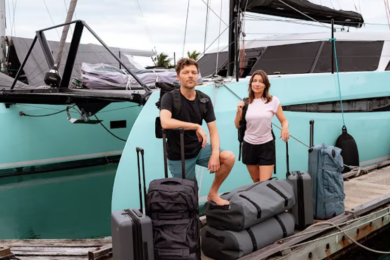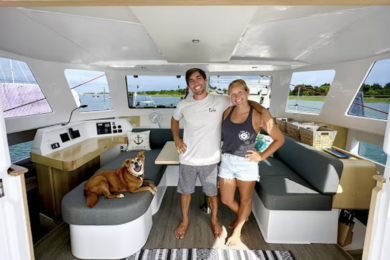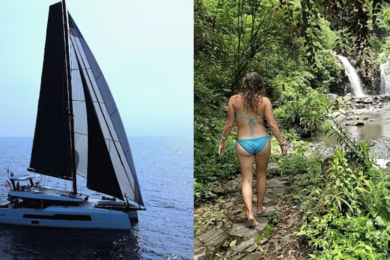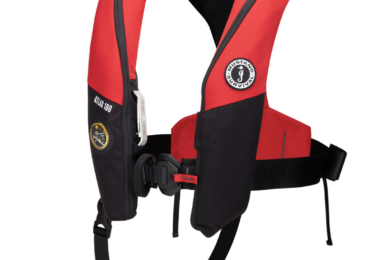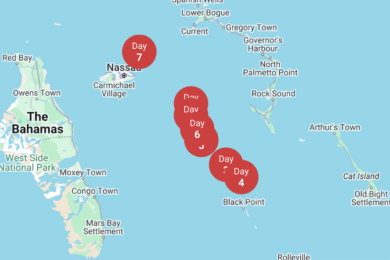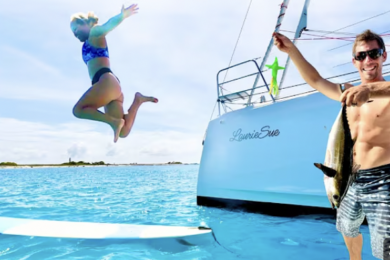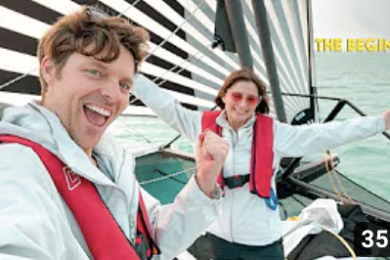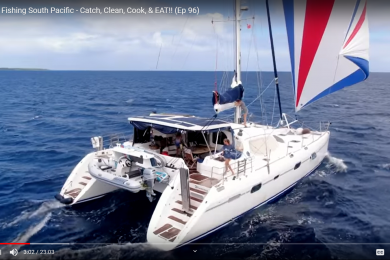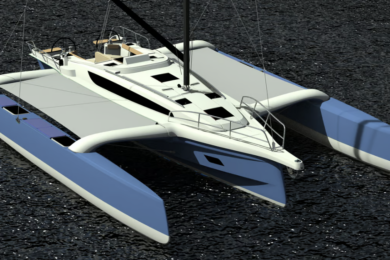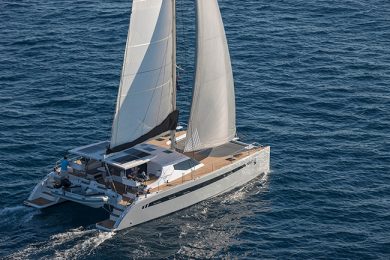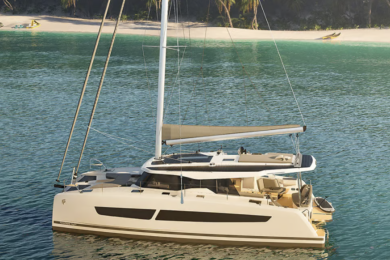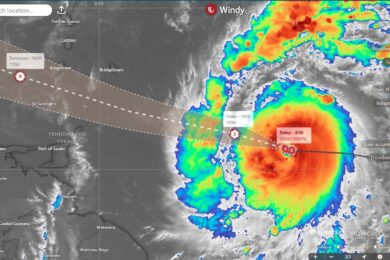
The art of big game trolling in the Gulf Stream. (Published Winter 2012)
I have trolled for small fish from an 18-foot Hobie for more than 20 years, customizing my boat with rod mounts, gear bags, bungee hand lines, a cup holder and fish keeper. The small size of my boat greatly limits the species I can pursue, as I am confined to a maximum of 10 miles from shore for safety reasons. My dream of combining my offshore sport fishing skills in the Gulf Stream via motorboat and chasing the big guys under the power of wind was realized after utilizing deep creative reasoning—not to mention perseverance in identifying a willing candidate.
In December 2010, I started looking at Google Satellite images of North Carolina ports in an effort to spot a big catamaran and pitch my crazy idea. After much ado, I found a few boat owners somewhat interested—most more apprehensive than excited. Eventually, Captain Richard Hodges rose through the ranks and stepped up to collaborate with me on my wind-powered Gulf Stream fishing experiment.
Richard fully embraced the paradigm shift where blue water catamaran sailing meets sport fishing, and we talked on the phone for two-and-a-half months. He sent pictures and together we visualized the process of basic logistical issues regarding mounting rods, gaffing and bringing fish on board. We schemed up a custom-mounted table top to dress fish and discussed coolers, ice storage, safety issues and large fish logistics. Leading up to the trip, I built numerous custom fishing rigs and got the rods ready.
GAME ON
At 3:45pm on an otherwise uneventful Monday afternoon, a crew of six big game fishermen plus a willing and initially somewhat tentative captain boarded a 42-foot Broadblue Sailing Catamaran. The impending trip would take us from St. Augustine, Florida to Cape Lookout, North Carolina by way of the productive big game waters of the Gulf Stream. The total distance was nearly 450 nautical miles—that is, if we went straight. More to that point later.
Captain Richard allowed the six gentlemen (I use this term loosely) on his boat having never met us, with the exception of our email and telephone exchanges. We were weighted down with more than 15 game fish rods, bags of gear, bait, gaffs, coolers of block ice, and one too few cases of beer. Captain Richard was kind enough to build a platform on the back of the boat for us to drill down eight rod holders and get the boat fishing-ready.
Motoring out of the St. Augustine Municipal Marina, we headed straight for the blue waters of the Gulf Stream and fished along the way. With hopes high, we started throwing lines in the water within an hour of departure and landed some king mackerel on the way to the Stream—a good sign for things to come. We celebrated with a bottle of wine, roasted vegetables and grilled tenderloin, which happened to be the only land-based meat we enjoyed the entire week.
By morning, we were on the blue waters of the Gulf Stream.
TAMING THE BEAST
We started fishing at daybreak on Tuesday. The bait of choice was ballyhoo, with colorful skirts mixed in with a couple artificial lures. It was a spectacular day, with good wind, and as the sun rose, we landed a huge bull mahi.

The cockpit of a sport fishing powerboat is specifically designed for fishing, so when landing or gaffing fish, you are low to the water. The freeboard on a sailing catamaran is five feet above the water. We found the easiest way to gaff a fish was to go down the steps at the stern of the hulls. If we were at all concerned about going in the drink while gaffing a fish at the bottom of the stairs, we would put on a harness.
This particular fish was too large to go directly into one of the large canyon bags, so we were forced to swing the monster into the cockpit, next to Captain Richard at the helm. All hell broke out: two gaffs in the fish, unproductive feet trying to pin it down, wild flipping and flapping, and a blood-covered cockpit.
The fish proceeded to kick a five-gallon bucket through the air into the saloon. We eventually iced the beast and reveled in our success. Captain Richard looked a bit overwhelmed with the thought of things to come as he squinted through his splattered sunglasses; then again, that might have been a look of utter joy in the spirit of this new adventure. We all learned that blood and guts wash off well with an onboard saltwater hose and a brush.
Throughout all of this, Captain Richard was a phenomenal sport, offering sailing tips, patience, a cool head and a keen desire to land more than a few trophy mahis himself. We discussed the finer things in life such as landing a big fish at sunrise, sushi, camaraderie, no access to phone and email…oh, and cocktails at 5:15pm.
On Wednesday, we caught many more mahi off the coast of Georgia, and at one point had to head back toward Jacksonville. A storm mass was coming at us like a slow motion train. In total, we had to radically change course three times during the trip to avoid violent electrical storms.
SHARK TALE
On Thursday morning south of Georgetown Hole just before sunrise, we hooked a mysterious Big One. We had enough hands on deck to clear all the lines and watch the show. The fish was fought for over an hour. After 45 minutes, we had it very close to the boat before it peeled off around 400 yards of line in short order. The angle of the line was steep and the fish was running deep, fast and far.
Captain Richard coached while we dropped the foresail, fired up both engines and backed down on the fish. Eventually, we got the fish to the boat before releasing it. It was an eight-foot long mako shark landed with textbook teamwork. A few hours and fish later, about 70 miles off Myrtle Beach, we caught two of the fattest blackfin tuna I have ever seen.


Many mahi later on Friday, we were in 130 feet of water still making our way to Cape Lookout. We put some deep rigs out with heavy in-line weights and caught a nice wahoo. Evening rolled around, and while cleaning fish and cocktailing on Voodoo Juice—one part rum, one part coconut rum, one part tequila, one part whiskey, fresh squeezed lime (mainly to prevent scurvy) and one part orange juice—we landed a nice king mackerel. Unfortunately, a shark attacked it near the boat, leaving us with only the front half to enjoy for dinner.
After night fell, a reel started screaming. After fighting for an hour and chasing the fish with the boat, the fight ended prematurely with a cut or broken line (we shall never know). Speculation is that it was a blue marlin. That night, we stayed on course for Cape Lookout but were beaten back by some electrical storms that appeared out of nowhere. We reversed course, eventually making it to port on Saturday morning.
A JOB FOR A SAILBOAT
Most of our sailing time was spent between 50 and 80 miles off the closest shoreline. At one point we were in just over 2000 feet of water chasing the elusive blue marlin. We ran eight lines simultaneously much of the time. All in all, we landed and iced more than 45 fish (not including several heartbreaking losses) totaling around 800 pounds. We stacked Captain Richard’s deep freezer to the top and filled the other large cooler with fish on block ice.
We ate like kings the whole way thanks to a bounty of catches and skilled chefs who grilled fish, made extravagant sushi (spicy tuna rolls were the bomb) and concocted delicious ceviche chased down with iced cold “michelada” style beers—one cold beer + one fresh lime squeezed over the rim + crushed salt + a few dabs of Tabasco. At the end of the trip, we had one ballyhoo and one beer left….perfect timing.
I am not sure what kind of sport fishing powerboats would have been able to make this trip. We traveled 450 nautical miles and were generally moving, trolling and fishing constantly for five days. A hypothetical 50-foot sport fishing boat burning 50 gallons of gas an hour over five days equals 6000 gallons of fuel. At $4 per gallon, the total comes out to $24,000.
Cost aside, I don’t know of any sport fishing boats with the fuel capacity and consumption to even think about such a trip. We used 30 gallons of fuel and caught more than 45 big fish in four solid days in the Gulf Stream. And did I mention we had one of greatest adventures of our lives?
Victor Jones is a native of NC, where he acquired his love of sailing and fishing. He is an architect and partner at Jenkins · Peer Architects and has a passion for combining catamaran sailing and fishing. Victor’s Piggly Wiggly t-shirt is his favorite. Doug Hollidge is an avid sport fisherman and a recent convert to the emerging wind-powered big game sport fishing world. Doug is the CEO of Five 9s Digital, LLC.
BACKING DOWN

On our trip, we only needed to back down on three fish—the mako shark, the wahoo and the mystery monster that got away. All the other fish up to 50 pounds could be handled simply by telling the autopilot to turn five or 10 degrees into the wind. This slows the boat to 1-3 knots depending on what you need to make decent headway on the fish.hen backing down on a fish in a motorboat, you simply pull the other lines in and start reversing—a sailboat may have to adjust or drop a sail. Twin diesels will turn a catamaran on a dime. Captain Richard did a tremendous job of this with the big fish.

Timing Is Everthing
The redundancy of multiple sails and two diesel engines is great for safety. Unless you are upside down, you will be going somewhere. It needs to be said that you need radar and GPS to be safe if you are doing this at night under either power or sail.hen going to the Stream in a large catamaran, you need a nice weather window. You should leave port in the afternoon and arrive at the hot spot the next morning just before daylight. This, combined with the fact that fuel is really not an issue, makes your range huge. Fish one or two (or more) days and arrive at the inlet at daylight. Your major travel time is spent sailing at night, maximizing your fishing time.

